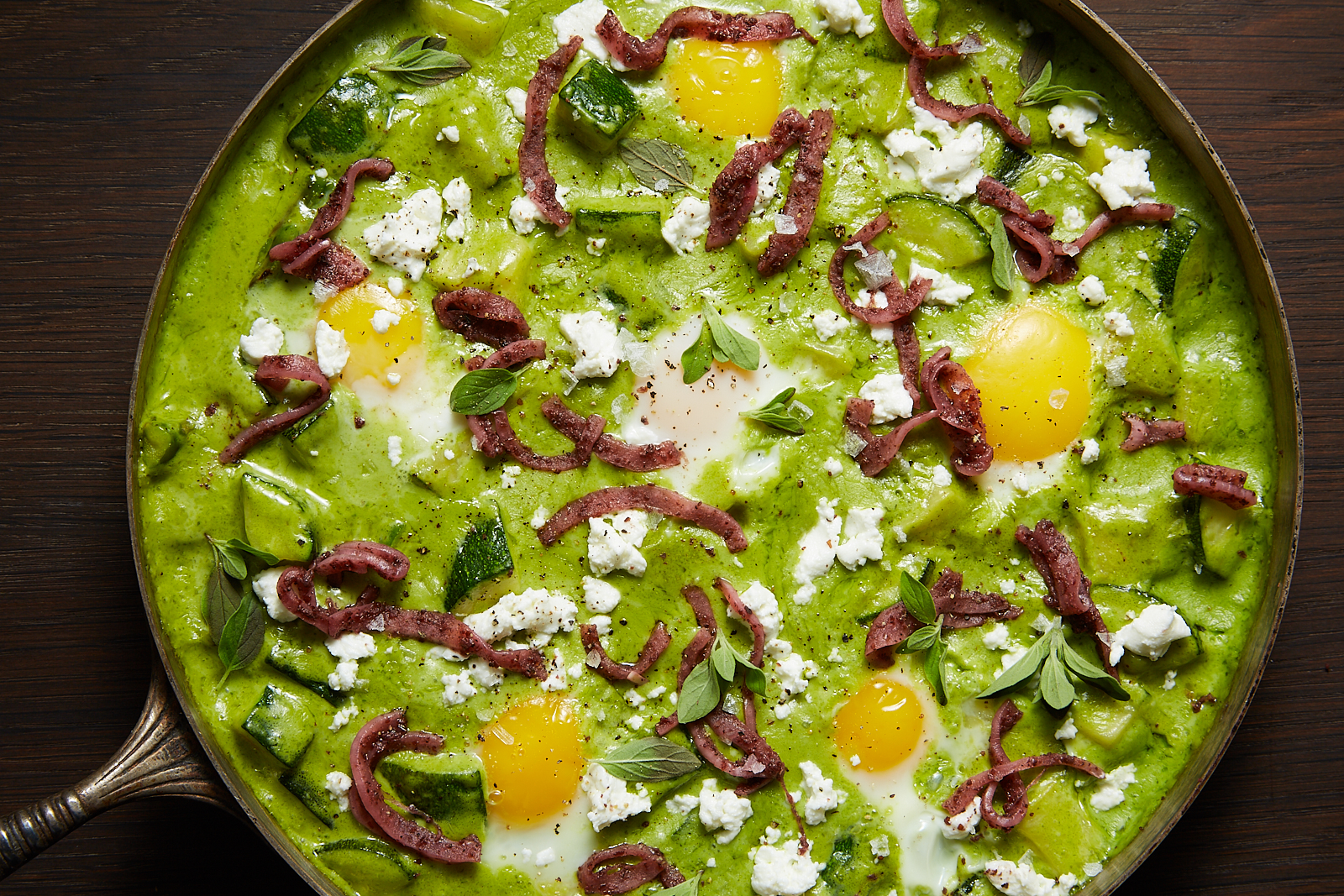The Green ‘Shakshuka’ an Israeli Chef Carried Around the World
Shared by Gabriel Israel
Recipe Roots: New York City > Tel Aviv
Gabriel’s grandfather, Georges Abitboul, at his desk in Los Angeles in 1970.
When Gabriel Israel was a child, he would wake up in his grandparents’ home in Antibes, France during the summer to the smell of his grandfather frying beignets, pillow-like doughnuts. His grandfather taught him to cook the doughnuts for three minutes per side, before removing them from the hot oil so they could be dusted with sugar and served warm. Gabriel’s visits with his grandparents helped him decide when he was just 10-years-old that he wanted to spend his life in the kitchen.
He started working in restaurants near his home in Ra’anana, a town 30 minutes north of Tel Aviv. During the army, he had the word “vision” tattooed along his inner arm and “determination” on his back. “I always had a vision of being a chef, one of the pillars of Israeli cuisine in the world,” he says.
Unsure of his path to get there, he moved to New York’s Hudson Valley to attend the prestigious Culinary Institute of America, but left before completing the program, finding his way to the kitchen at New York’s acclaimed Boulud Sud.
Despite the French leanings of the restaurant, the Israeli staple “shakshuka was a popular dish there,” even before he arrived, Gabriel explains. “They knew I was Israeli,” he adds, so he was assigned to make 200 hundred orders of shakshuka for brunch each weekend. His colleagues nicknamed him “shuka,” which was easier for them to say than “Gabriel.” “There was an [Israeli] guy before me — his name was couscous,” Gabriel jokes.
The restaurant wasn’t the right fit, but it showed him just how popular shakshuka was. “I said: ‘why not take shakshuka and make it the whole concept?’” he recalls. He and his closest friends decided to open a food truck that would specialize in shakshuka. The team went to the licensing office only to find out that they would have to join a seven year waiting list. He called his father who said: “Gabriel, you’re an Israeli, find a way. Until then, I’m not talking to you.” Within three weeks, Gabriel found a solution and ultimately launched The Shuka Truck.
The truck was a hit with New Yorkers. And, the Israeli consulate brought the team to London, Colombia, and Russia to serve shakshuka, sometimes out of a rented truck. The team served not only a classic shakshuka, but reinterpreted versions as well, including what Gabriel calls his green shakshuka made with spinach, zaatar, coriander, and oregano. “I wanted to [serve] something with my French roots,” he explains, so he worked in a classic French sauce of spinach and cream, and added goat cheese and asparagus, which he says always makes him think of France. Zaatar, is a nod to his Middle Eastern upbringing.
While the truck closed after 18 months, Gabriel has held on to the recipe. Soon, he will start serving it as part of the all-day menu at L28 culinary platform, the new restaurant at Start-Up Nation Central in Tel Aviv.
“Israeli cuisine is a melting pot of cultures, it’s a fusion,” Gabriel says. “I’m French and Moroccan, that was born in America, that grew up in Israel. That’s my food.”
Gabriel shared a version of this story at our Schmaltzy in Tel Aviv to help celebrate the launch of Start-Up Nation Central.
Green Shakshuka
Photos by Penny De Los Santos
Serves: 6-8
Time: 45 minutes
Ingredients
For the pickled onions:
1 red onion, thinly sliced
2 tablespoons sumac
¼ teaspoon kosher salt
For the sauce:
1 tablespoon extra virgin olive oil
1 Spanish onion, thinly sliced
1 clove garlic, roughly chopped
1 bunch asparagus, tough ends removed, heads reserved, cut into 1“ pieces
1 tablespoon za’atar
½ tablespoon coriander
1 cup fresh oregano leaves, picked
4 cups heavy cream
2 bags baby spinach (10 oz.)
Salt
Pepper
For Finishing:
1 tablespoon olive oil
2 small zucchini, cut into ½” cubes
8 eggs
2 oz. goat cheese, crumbled
2 tablespoons fresh oregano, leaves picked
Preparation
1. In a small nonreactive bowl, mix the red onion, sumac and salt and let sit for at least an hour.
2. In a medium saucepan, heat the oil over medium-low heat. Add the onion, garlic, and asparagus stems and sauté until the onions are translucent and asparagus is bright green, but not yet fully cooked, about 5 minutes.
3. Add the za’atar, coriander, oregano and ½ teaspoon of salt and sauté for 1 minute. Add the heavy cream and bring to a low simmer. Add spinach and mix to incorporate until spinach is just wilted. Let mixture sit for a few minutes until cool enough to handle.
4. Carefully transfer the mixture to a blender and process until smooth. Taste and adjust for seasoning and then place in the fridge to cool. This can be done up to two days in advance.
5. To finish, heat the oil in a large pan over medium-high heat. Add the zucchini and reserved asparagus heads. Sprinkle with salt and pepper. Add the sauce and bring to a simmer, cooking until zucchini and asparagus are bright green and the sauce thickens a bit, about 3-5 minutes. Gently crack each of the eggs on top of the mixture, sprinkling each yolk with salt. Cover the pan and cook for 3-4 minutes on medium heat until egg whites are cooked through and yellows are still runny.
6. Top with the pickled sumac onions, goat cheese, and fresh oregano. Serve immediately with fresh pita.








